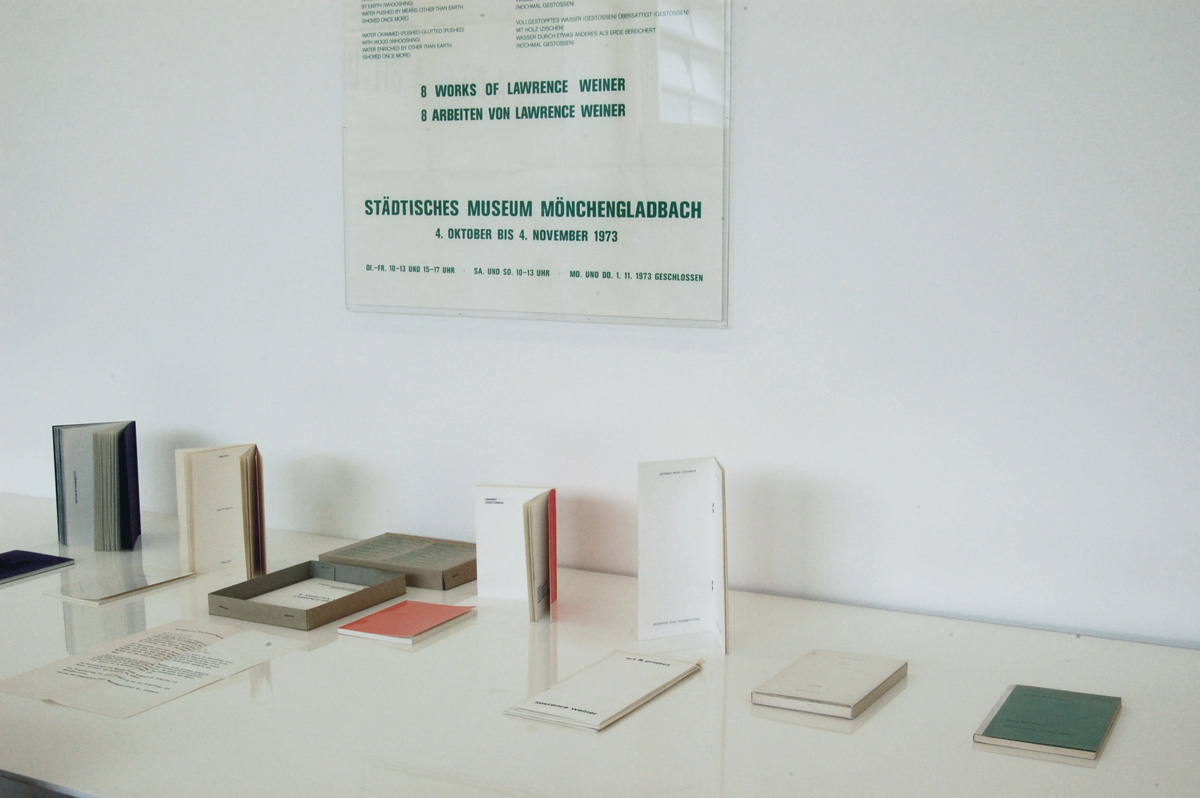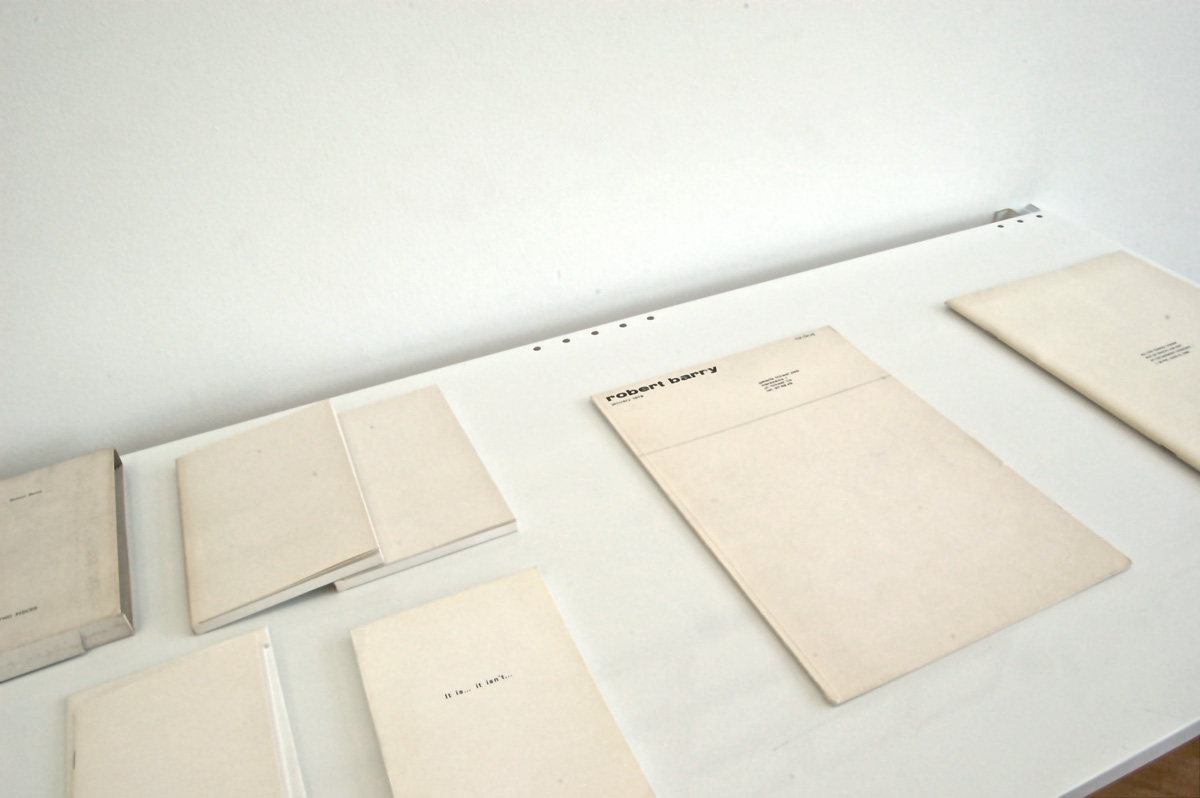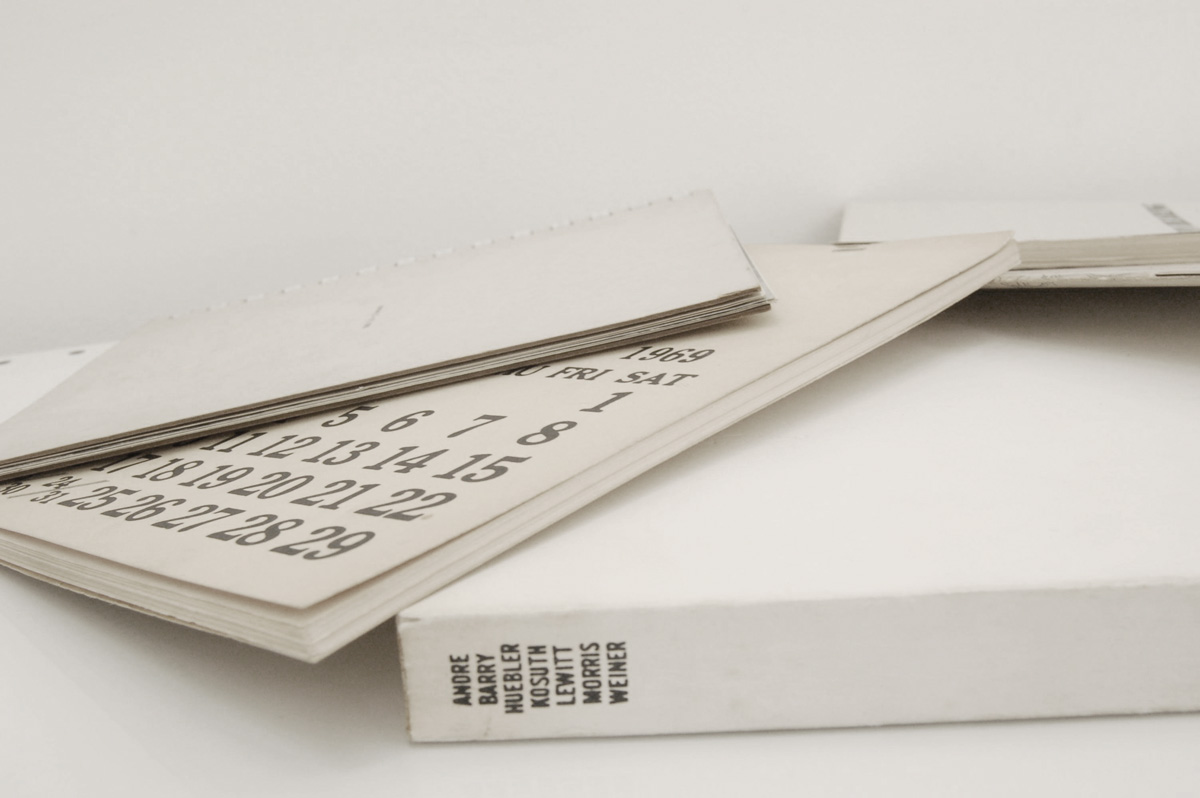Arte as Project as Book
Curated by Diana Dobránszky

An important section of the moraes-barbosa collection
consists of brochures, posters, artists’ books and vinyl albums
of some of the most important conceptual artists of the 1960s
and 70s. In order to provide access to a wider audience to
this material the exhibition Art as Project as Book presents
books, works and vinyls by Douglas Huebler, Lawrence
Weiner, Robert Barry, Seth Siegelaub and Stanley Brouwn.
Douglas Huebler [1924 - 1997, EUA]


“The world is more or less full of objects, more or les interesting. I do not wish to add anymore. I prefer, simply, to state the existence of things in terms of time and place.”
Douglas Huebler abdicated the creation of objects and, interested in the idea of gestalt, directed his work to the development of project that deal with experiences in theworld. His proposals depart from the creation of conceptual, random or logical systems, which determine actions in specific or indistinct places, to be performed by him or by others. These actions are documented through photographs, typewritten texts, drawings, maps, etc. Hueble uses in his systems time and space as units of measurement–the titles of his series are first of all descriptive, such as Duration, Variable, Location–and the artifacts resulting from the events are evidence tha characterize the process. Through this method, the artist seeks to create a kind of art inserted in the context of life and that is not intended as a visual transposition of human perceptions. Instead, he seeks to report them. Inevitably, his works lead to the question of the capacity of these records to communicate the wholeness of an experience. However, the viewer can reconstruct it in his or he imagination, somehow, through the traces presented by the artist.
Lawrence Weiner [1942, EUA]






1. THE ARTIST MAY CONSTRUCT THE PIECE.
2. THE PIECE MAY BE FABRICATED.
3. THE PIECE NEED NOT BE BUILT.
EACH BEING EQUAL AND CONSISTENT WITH THE
INTENT OF THE ARTIST, THE DECISION AS TO CONDITION RESTS WITH THE RECEIVER UPON THE OCCASION OF RECEIVERSHIP.
Statement of Intent, 1968
Lawrence Weiner defines art as the act of posing questions, and his interest as an artist is to awaken in the spectator the ability to see the world in other ways. Since 1968 the construction of a work has become irrelevant to his practice–communicating an idea would be enough to fulfill its purpose. Since then Weine uses language as an instrument. The enigmatic phrases he creates appear in the form of statements or propositions, as chains of words. Sometimes they deal with the specific, sometimes with the general; but they are mainly arranged in singular structures in which content is form. The statements appear to belong to a larger context, which is the object of investigation by the spectator. Weiner uses verbs in abundance, mainly in the passive voice, denoting actio or change of state, and associates them in various ways, multiplyin the semantic possibilities. The artist’s premise is to refrain from imbuin the texts with meaning, which gives them potency: the metaphorization and the interpretation are constructed by the viewer. By having its own characteristics, the book platform provides a different experience of his language. The sequence, the break of the pages and the punctuation are elements that allow for other structures. In fact, Weiner considers the language a kind of sculpture that moves and adapts to different environments, languages, generations and cultures.
Robert Barry [1936, EUA]



“[...] I use the unknown because it is the occasion for possibilities, an because it’s more real than anything else. Some of my works consist of forgotten thoughts, or things in my unconscious. I also use things that are not communicable, are unknowable, or are not
yet known. The pieces are actual but not concrete; they have a different kind of existence. [...]”
A work submitted to
Prospect ‘69, Düsseldorf
The work of Robert Barry transcends the materiality and explores the transient, the incommunicable and the invisible. Radio waves, gas emissions and thoughts are some of the unusual materials with which he works. The primary means of communication he uses is the written language. In his works, words and phrases are presented in a structured manner and at the same time seemingly random and interchangeable. The texts never determine what they refer to, which makes the reader a co-author, in so far as it is delivered to him or her the task to explore the possibilities of meaning. The intention is to provoke a chain of ideas and relations since the words have no referent or significier determined. In his books, in which the texts are longer and involve a closer relationship with the reader, the definition process is never realized and the words, alone in most pages, seem to expand and acquire a certain individuality, Barry can create random circuits that have the ability to generate fluidity in reading and put the viewer in a trance state, trapped in a maze of possibilities.
Seth Siegelaub [1941 - 2013, EUA – 2013]



“For many years it has been well known that more people are aware of an artist’s work through (1) the printed media or (2) conversation than by direct confrontation with the work itself. [...] When art concerns itself with things not germane to physical presence, its intrinsic (communicative) value is not altered by the presentation in printed media. The use of catalogues and books to communicat (and disseminate) art is the most neutral means to present the new art. The catalogue can now act as primary information for the exhibition, as opposed to secondary information about art in magazines, catalogues, etc., and in some cases the ‘exhibition’ can be the catalogue.”
Although he was an independent curator for only a few years (1964-1972), Seth Siegelaub played a key role as facilitator and promoter of the Conceptual Art of the 1960s and 70s. In consonance with artists who considered the idea and the process more important than the materialization of the work, Siegelaub realized that a physical space was not necessary to show the works with which he dealt, all he needed was a means to communicate them. He found in printed format the context in which the project-works could be presented. The books he edited–or curated–were, in fact, exhibitions themselves. By turning catalogues into autonomous artistic platforms, Siegelaub questioned the arts system in which he was inserted: how art is created, displayed, distributed and experienced. At the time, the discussion of how museums related to artists and works took great proportions. In 1969 a group of artists founded the Art Workers’ Coalition (AWC)–of which Siegelaub to part–that entered into a direct confrontation with MoMA. Encouraged by the debate, Seigelaub created the Artist’s Reserved Rights Transfer and Sale Agreement, a model of contract that intended to balance the political and economic forces of the artists over their works.
Stanley Brouwn [1935, Suriname]



“Never before have distances been so meaningless as nowadays. Increasingly more people fly long distance several times a year. The validity of the concept of distance is becoming still further eroded. In my work distances are recharged again. They regain meaning.”
Stanley Brouwn’s works deal with the concept of space in terms of displacement. As a counterpoint to the distortions caused to physical transportation by technology, the artist recovers the notion of natural movement of the body through space. He documents his movements in various ways (mainly using as a measure his own strade): a line on paper, texts and numbers in records stored in file boxes or notebooks–which are the materials of presentation of his works in museums and books. In his books he records the steps taken in different countries, as well as creates notions of distance through abstract data–the distance from a given location to another, imaginary or generic. At other times, no information beyond the amount of steps appears, or reference to any specific location. In presenting these records, as data, Brouwn raises the awareness of movement as a measure of the world. In the series of works entitled This Way Brouwn the artist asks people to explain to him how to get from where they are to another place. Each person explains the path in a way: with words, with drawings, giving reference points, using certain vocabulary. The resulting cards of this interaction are a compendium
of how people relate to the space of the city.
ARTISTAS: Douglas Huebler, Lawrence Weiner, Robert Barry, Seth Siegelaub e Stanley Brouwn.